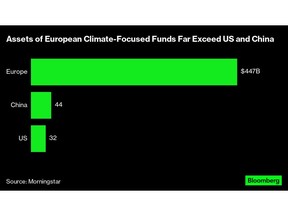The US has fallen far behind Europe, as well as China, but it may be waking up.
Author of the article:
Bloomberg News
Tim Quinson
Published Oct 11, 2023 • 3 minute read
 o)opaj8p(m375qjdmau[5u53_media_dl_1.png Source: Morningstar
o)opaj8p(m375qjdmau[5u53_media_dl_1.png Source: Morningstar
(Bloomberg) — It turns out the market for environmental-related investment funds is really small in the US, relative to Europe and even China.
Roughly $32 billion was allocated to US climate funds as recently as the end of June, compared with about $447 billion in Europe and $44 billion in China, according to data compiled by Morningstar Inc.
Article content
“The global picture shows the US is clearly behind its biggest, competing markets,” said Hortense Bioy, Morningstar’s global director of sustainability research.
Advertisement 2
This advertisement has not loaded yet, but your article continues below.
THIS CONTENT IS RESERVED FOR SUBSCRIBERS ONLY
Subscribe now to read the latest news in your city and across Canada.
Exclusive articles by Kevin Carmichael, Victoria Wells, Jake Edmiston, Gabriel Friedman and others.Daily content from Financial Times, the world’s leading global business publication.Unlimited online access to read articles from Financial Post, National Post and 15 news sites across Canada with one account.National Post ePaper, an electronic replica of the print edition to view on any device, share and comment on.Daily puzzles, including the New York Times Crossword.
SUBSCRIBE TO UNLOCK MORE ARTICLES
Subscribe now to read the latest news in your city and across Canada.
Exclusive articles by Kevin Carmichael, Victoria Wells, Jake Edmiston, Gabriel Friedman and others.Daily content from Financial Times, the world’s leading global business publication.Unlimited online access to read articles from Financial Post, National Post and 15 news sites across Canada with one account.National Post ePaper, an electronic replica of the print edition to view on any device, share and comment on.Daily puzzles, including the New York Times Crossword.
REGISTER TO UNLOCK MORE ARTICLES
Create an account or sign in to continue with your reading experience.
Access articles from across Canada with one account.Share your thoughts and join the conversation in the comments.Enjoy additional articles per month.Get email updates from your favourite authors.
Article content
The US currently represents just 6% of climate-fund assets—a pittance given the overall size of the country’s capital markets. A big reason for the poor performance is most of the money has been steered to companies in the solar and wind sectors, a part of the US equity market that’s been battered over the past two years by rising interest rates, Bioy said.
In contrast, she said European funds have attracted investors at a rapid clip, particularly those that concentrate holdings in companies that take the climate crisis into consideration in their business strategies and thus are better prepared for the transition to a low-carbon economy.
Simultaneously, regulation has played a prominent role in the proliferation of actively run and passively managed climate-transition funds in Europe following the introduction in 2021 of Paris-aligned and climate-aligned benchmarks, Bioy said.
The benchmarks are designed to consider climate-risk mitigation and provide investment options by setting a yearly decarbonization target of at least 7%, which is in line with the decarbonization trajectory of the Intergovernmental Panel of Climate Change’s 1.5C scenario.
By signing up you consent to receive the above newsletter from Postmedia Network Inc.
Article content
Advertisement 3
This advertisement has not loaded yet, but your article continues below.
Article content
As for China, the country’s commitment to reach peak carbon dioxide emissions by 2030 and carbon neutrality by 2060 has buoyed interest in the asset class. Given these overarching objectives, numerous fiscal incentives have mushroomed at the provincial and municipal levels, including monetary rewards for companies realizing annual carbon emission reduction targets, as well as subsidies for research and development projects that contribute to better energy efficiency, according to Morningstar researchers.
Read more: Xi’s ESG Boom Funnels Billions Into Coal, Defense Stocks
Chinese companies also are benefiting from the country’s supply-chain dominance of renewable energy infrastructure and materials, including photovoltaic panels, wind turbines and electric vehicle batteries.
“The bottom line is the US has a lot of catching up to do as it pertains to providing investors with solutions to manage climate-related risks and opportunities in investment portfolios,” she said.
Morningstar counts more than 1,200 funds with a climate-related mandate, up from less than 200 in 2018. Roughly 870 of the offerings are in Europe, compared with 223 in China and 117 in the US. The funds are separated into five buckets: climate-transition funds (which are particularly popular in Europe), low carbon, green bond, climate solutions and clean energy or clean technology funds.
Advertisement 4
This advertisement has not loaded yet, but your article continues below.
Article content
A look under the hood shows that climate-transition funds—whether they’re managed from Europe or the US—have stakes in many of the same companies, including Alphabet Inc., Schneider Electric SE, Microsoft Corp., ASML Holding NV and Roche Holding AG. These are companies that are seen as taking into account the effects of global warming when they map out their business strategies.
Climate-transition funds are the fastest-growing part of the marketplace. Just last week, BlackRock Inc., the world’s biggest asset manager, said it’s launching the Climate Transition-Oriented Private Debt Fund.
Read more: One US ESG Fund Strategy Has Grown More Than 300%
In the 18-month period ended in June, roughly $5.8 billion went into climate-transition funds in the US, with almost three quarters of that cash going to two exchange-traded funds: Xtrackers MSCI USA Climate Action Equity (ticker USCA) and iShares Climate Conscious & Transition MSCI USA (USCL), according to Morningstar. Those inflows helped offset the outflows from clean energy and tech funds, including the ishares Global Clean Energy ETF (ICLN), which suffered more than $500 million of net withdrawals.
US-based investors have certainly trailed their European counterparts in identifying the energy transition that’s slowly taking place, but they now seem to be finally waking up.
Article content
>>> Read full article>>>
Copyright for syndicated content belongs to the linked Source : Financial Post – https://financialpost.com/pmn/business-pmn/europe-dominates-climate-fund-investing































